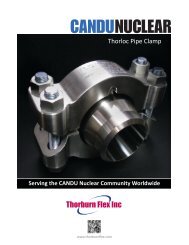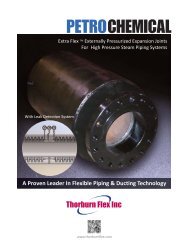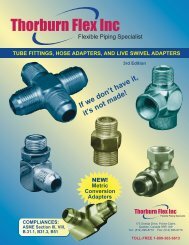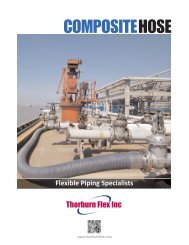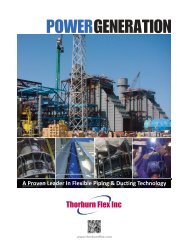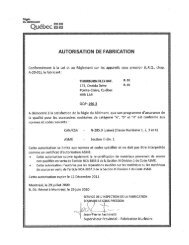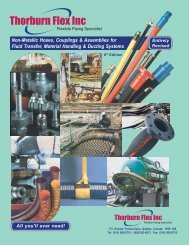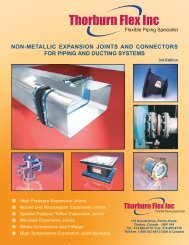Metallic Expansion Joints - Thorburn Flex Inc
Metallic Expansion Joints - Thorburn Flex Inc
Metallic Expansion Joints - Thorburn Flex Inc
Create successful ePaper yourself
Turn your PDF publications into a flip-book with our unique Google optimized e-Paper software.
THORBURN<br />
FLEXIBLE PIPING SPECIALIST<br />
HOW TO INTERPRET THORBURN'S<br />
BELLOWS DESIGN ANALYSIS DOCUMENTATION<br />
All custom bellows designs should be documented to prove that the design has been analyzed to the proper code, the design<br />
is safe and mechanically stable, the cycle life is in accordance with the specification requirements and the important stress<br />
values have been satisfied. <strong>Thorburn</strong> bellows design analysis shows all the critical information in a summary format. This<br />
paper is offered to help a customer interpret the information that is shown on <strong>Thorburn</strong>'s bellows design analysis so the<br />
information is more meaningful.<br />
THORBURN REF: ABI-001-06/19/95 ITEM: 01 THORBURN EQUIPMENT INC.<br />
CUSTOMER REF: LTD-401<br />
SHEET __/__ OF __/__<br />
JUNE 19, 1995 REV 08-06-92<br />
PREPARED BY: LUCIAN BODOCAN<br />
APPROVED BY:KEN McCORMICK<br />
The bellows' effective area is the area of the<br />
bellows that creates pressure thrust when<br />
acted upon by the operating pressure. The<br />
system anchors and/or the hardware on the<br />
expansion joint must be designed to<br />
withstand pressure thrust at the operating<br />
and test conditions.<br />
Torsional spring rate is offered for those pipe<br />
stress analysts who are inputting bellows<br />
characteristics into a pipe stress program.<br />
Bellows are not generally designed for<br />
torsional movements. But, the torsional<br />
stiffness value can affect the output of a pipe<br />
stress analysis that includes a <strong>Thorburn</strong><br />
expansion joint.<br />
THORBURN SINGLE BELLOWS DESIGN ANALYSIS<br />
THIS EXPANSION JOINT DESIGN ANALYSIS WAS CALCULATED WITH THE DESIGN<br />
EQUATIONS STATED IN THE STANDARDS OF THE EXPANSION JOINT MANUFACTURER'S<br />
ASSOCIATION INC., SIXTH EDITION.<br />
CODE REQUIREMENT: ANSI B31.3<br />
DESIGN PRESSURE:<br />
256 PSI<br />
DESIGN TEMPERATURE:<br />
266 DEG. F<br />
BELLOWS MATERIAL:<br />
A240-T304<br />
ALLOWABLE STRESS:<br />
17,000 PSI<br />
MODULUS OF ELASTICITY:<br />
27,304,000 PSI<br />
WELD JOINT EFFICIENCY 0.85<br />
DESIGN MOVEMENT CONDITIONS<br />
COND AXIAL LATERAL ANGULAR S5 S6 CYCLES TYP<br />
A. 0.25 0.13 0.10 0.20 1.00 2.00 2515 179315 4780<br />
INSIDE DIAMETER:<br />
OUTSIDE DIAMETER:<br />
NUMBER OF CONVOLUTIONS:<br />
MATERIAL THICKNESS:<br />
NUMBER OF PLIES:<br />
FREE LENGTH OVER CONVOLUTIONS:<br />
7.250 IN<br />
8.500 IN<br />
14 CONS<br />
0.024 IN<br />
2 PLIES<br />
8.75 IN<br />
S2 (CIRCONFERENTIAL MEMBRANE STRESS DUE TO PRESSURE): 9,206 PSI<br />
S3 (MERIDIONAL MEMBRANE STRESS DUE TO PRESSURE): 1,598 PSI<br />
S4 (MERIDIONAL BENDING STRESS DUE TO PRESSURE): 25,051 PSI<br />
S5 (MERIDIONAL MEMBRANE STRESS DUE TO DEFLECTION): SEE TABLE ABOVE<br />
S6 (MERIDIONAL BENDING STRESS DUE TO DEFLECTION): SEE TABLE ABOVE<br />
S t (STRESS RANGE FOR PRIMARY DESIGN CONDITION): 200,485 PSI<br />
DESIGN CYCLE LIFE FOR PRIMARY DESIGN CONDITIONS: 3,000 CYCLES<br />
RATED CYCLE LIFE FOR PRIMARY DESIGN CONDITION:<br />
4,780 CYCLES<br />
MAXIMUM DESIGN PRESSURE BASED ON SQUIRM:<br />
AXIAL SPRING RATE:<br />
LATERAL SPRING RATE:<br />
ANGULAR SPRING RATE:<br />
TORSIONAL SPRING RATE:<br />
BELLOWS EFFECTIVE AREA:<br />
361 PSI<br />
1,220 LBS/IN<br />
1,500 LBS/IN<br />
167 IN LBS/DEG<br />
74,457 IN LBS/DEG<br />
49.30 SQ/IN<br />
The proposed design has this calculated cycle<br />
life at the specified conditions.<br />
There are two types of squirm or instability<br />
that can occur for internally pressurized<br />
bellows. One is called column squirm (similar<br />
to buckling of a column) and the other is called<br />
in-plane squirm (localized plastic deformation).<br />
<strong>Thorburn</strong> calculated the maximum<br />
design pressures based on the most<br />
conservative of the two methods. The value<br />
stated on the design analysis is the predicted<br />
squirm pressure with a safety factor of 2.25.<br />
<strong>Thorburn</strong>'s spring rate calculations are based<br />
on the elastic spring rate criteria from EJMA.<br />
This is the actual temperature that was used for the<br />
bellows design. For certain special applications such as<br />
refractory lined expansion joints, the bellows is designed<br />
for a lower temperature than the media.<br />
This is the allowable stress for the bellows material at<br />
the bellows design temperature.<br />
This is the modulus of elasticity of the bellows material at<br />
the design temperature which is used to calculate spring<br />
rate and column squirm pressure. The room temperature<br />
modulus of elasticity is used to calculate the deflection<br />
stresses (S5 & S6).<br />
The weld joint efficiency is 1.0 if the bellows' longitudinal<br />
weld is 100% radiographically examined in accordance<br />
with the specified code.<br />
The design movements create the deflection stresses that<br />
determine cycle life. One complete cycle is based upon<br />
moving the bellows from the neutral length to position 1,<br />
back through the neutral length to position 2 and then<br />
back to the neutral length.<br />
Material thickness is generally stated as the standard<br />
sheet gauge thickness.<br />
S2 (hoop stress) is an important membrane stress that<br />
runs circumferentially around the bellows. The value must<br />
be lower than the allowable stress for the bellows' material<br />
multiplied by the bellows' longitudinal weld joint efficiency.<br />
S4 (pressure bending) is an important bending stress<br />
that is located in the side wall of the convolution running<br />
in the longitudinal direction. It is the stress that makes a<br />
"U" shaped convolution balloon out into an omega shape.<br />
The value of (S3 + S4) must be lower than the allowable<br />
stress of the bellows’ material multiplied by material<br />
strength factor which is equal to 3.0 for bellows in the as<br />
formed condition (with cold work) and 1.5 bellows in the<br />
annealed condition (without cold work).<br />
S6 (deflection bending) is the primary bending stress<br />
influencing fatigue life. This stress runs in the longitudinal<br />
direction and is most severe in the side wall of the<br />
convolution near the crest of root. There is no upper limit<br />
on this stress. It is calculated based on elastic theory,<br />
and the value of S6 is generally far in excess of the yield<br />
strength of the bellows material. That means that a typical<br />
expansion joint bellows undergoes plastic strain during<br />
each stroke.<br />
This is the specified cycle life expectancy value as per<br />
EJMA, ANSI B31.3 Appendix X, ASME Section VIII or<br />
ASME Section III Equations.<br />
Page 13





